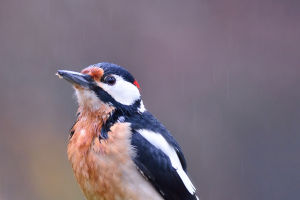Insects do not have very good eyesight, but the dragonfly is an exception, its compound eyes are particularly large. The entire head is almost occupied by compound eyes. Do you know how many eyes a dragonfly has?
You may not believe it when you say it, but the big eyes of a dragonfly are made up of 10,000 - 28,000 small eyes. This is the most in insect festivals, so it has particularly good eyesight among insects, and can see things five or six meters away. Dragonfly eyes appear to be round and large, occupying almost 2/3 of the area of their head.
Moreover, dragonfly eyes have a very interesting function: the upper part of the entire eye is responsible for seeing distant objects, and the lower half is responsible for seeing near objects.
This division of labor enables it to take care of both distance and distance when preying, and it is timely and accurate.
But if you move quickly on the upper part of the dragonfly's eye, it will be dizzying and easily caught, which is also the weak point of the dragonfly's eye.
Dragonflies' eyes are particularly sensitive to moving objects, and can determine the direction and speed of the movement of prey based on the direction and time when the little flying insect moves from one ommatidium to another.
When an object suddenly appears, it takes 0.05 seconds for the human eye to see the outline clearly, while the dragonfly takes less than 0.01 seconds to see clearly. Therefore, it is easy for dragonflies to catch their prey.
A Japanese research team reported in the new online edition of the Proceedings of the National Academy of Sciences of the United States that they found that dragonflies have an exceptionally large variety of genes involved in distinguishing colors, and can use different combinations of color vision genes according to different environments.
For the development of light sensors that adapt to different light environments.After light is converted into electrical signals by photoreceptor cells in the eyeball, its information is processed in the brain.
In photoreceptor cells, there are opsins that function as light sensors, and the synthesis of these opsins is directed by different opsin genes.
Researchers from the Japan Institute of Industrial Technology said that many animals have only 3 to 5 opsin genes. For example, there are 3 opsin genes in humans, which can form "light sensors" for blue, green, and red primary colors.
Various colors based on the three primary colors. For this reason, humans can see red and purple, etc., but not ultraviolet. Honeybees and fruit flies have opsin genes for ultraviolet light, but not for red light, so they can see ultraviolet light but not red.


